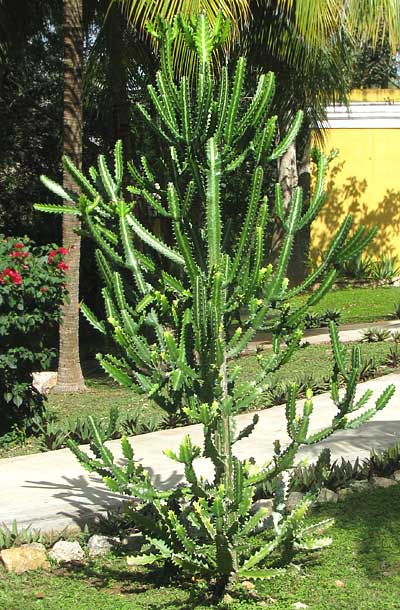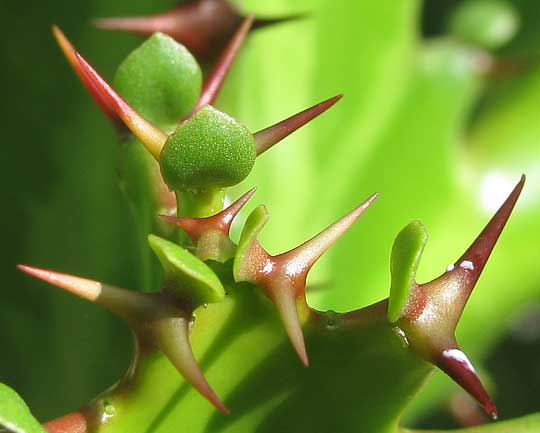Excerpts from Jim Conrad's
Naturalist Newsletter
from the January 24, 2010 Newsletter issued from Hacienda Chichen Resort beside Chichén Itzá Ruins, central Yucatán, MÉXICO; limestone bedrock, elevation ~39m (~128ft), ~N20.676°, ~W88.569°
CANDELABRA "CACTUS" LEAVES
In little-watered rock gardens with abundant sunlight you've probably seen such spiny, much-branched succulents as the eight-ft-tall (2.5 m) one shown below:

Among the plant's several English names are Candelabra Cactus, False Cactus and Dragon Bones. Despite all the spines and the term "cactus" appearing in the name list, the plant isn't a cactus at all -- not a member of the Cactus Family. It's a member of the Spurge Family, in which we also find Castor-Bean, Cassava and Poinsettias, none of which look much at all like what's in the picture. The tiny flowers, however, are similar on them all, and flowers and fruits indicate taxonomic relationships much better than vegetative parts.
What's in the picture is EUPHORBIA LACTEA, a native of South Africa but planted worldwide. The "lactea" in its technical name refers to milky latex it leaks when injured. Break off a stem segment and lots of "milk" runs down the stem. The latex is full of diterpene esters, which means that it's mildly toxic if eaten, and burns the skin for a few minutes if it gets on you. It's a lot worse if it gets in your eyes, however.
You might wonder about this plant's leaves. Did it simply lose them during evolution the way hominoids lost their tails? The answer is shown below:

That picture shows how the Candelabra Cactus's spines occur in pairs along each stem sections' three or four angles, and how each pair of spines is associated with a tiny, green, heart-shaped leaf.
To appreciate better what you're seeing there, remember that many leaf stems, or petioles, have a pair of stipules at their bases. Usually stipules are much smaller than the leaves they subtend, and most stipules fall off when their leaf is fully developed. You can see stipules, their scars, and read about them at www.backyardnature.net/woodtwig.htm.
Candelabra Cactuses have switched the roles of its leaves and stipules. With them, the two stipules have enlarged and modified into two hard spines, while the leaves have drastically diminished, and fall off soon after being produced. Most of the time a Candelabra Cactus bears no leaves at all, or only at the tips of its youngest stem segments. Therefore, among Candelabra Cacti, nearly all photosynthesis is accomplished by the stem, not by leaves. This situation most often evolves in plant species adapted to arid conditions, one reason being that there is less water loss, because of there being less surface area, in a roundish stem than on a similarly sized flattish leaf.